Rock Pigeon
Conservation status Least concern |
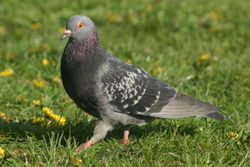
Rock Pigeon near the shore in Connecticut
|
|
Scientific classification |
| Kingdom: |
Animalia
|
| Phylum: |
Chordata
|
| Class: |
Aves
|
| Order: |
Columbiformes
|
| Family: |
Columbidae
|
| Genus: |
Columba
|
| Species: |
C. livia
|
|
|
Binomial name |
Columba livia
Gmelin, 1789 |
The Rock Pigeon (Columba livia), is a
member of the
bird family
Columbidae, doves and pigeons. The bird is also known by
the names of feral pigeon or domestic pigeon.
In common usage, this bird is often simply referred to as
the "pigeon". The species was commonly known as Rock Dove
until the
British Ornithologists' Union and the American
Ornithologists' Union changed the official
English name of the bird in their regions to Rock Pigeon.
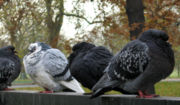
Feral Rock Pigeons commonly show a very wide
range of plumage variation
The Rock Pigeon has a restricted natural resident range
in western and southern
Europe, North Africa, and into southwest Asia. Its habitat
is natural cliffs, usually on coasts. Its domesticated form,
the feral pigeon, has been widely introduced elsewhere, and
is common, especially in cities, over much of the world. In
Britain, Ireland, and much of its former range, the Rock Pigeon
probably only occurs pure in the most remote areas. A Rock
Pigeon's life span is anywhere from 3–5 years in the wild to
15 years in captivity, though longer-lived specimens have
been reported.
The species was first introduced to North America in 1606
at Port Royal, Acadia (now Nova Scotia).
The Rock Pigeon is 30–35 cm long with a 62–68 cm
wingspan. The white lower back of the pure Rock Pigeon is
its best identification character, but the two black bars on
its pale grey wings are also distinctive . The tail is
margined with white. It is strong and quick on the wing,
dashing out from sea caves, flying low over the water, its
white rump showing well from above.
The head and neck of the mature bird are a darker
blue-grey than the back and wings; the lower back is white.
The green and lilac or purple patch on the side of the neck
is larger than that of the
Stock Dove, and the tail is more distinctly banded.
Young birds show little lustre and are duller. Eye colour of
the pigeon is generally an orange colour but a few pigeons
may have white-grey eyes. The eyelids are orange in colour
and are encapsulated in a grey-white eye ring.
When circling overhead, the white under wing of the bird
becomes conspicuous. In its flight, behaviour, and voice,
which is more of a dovecot coo than the phrase of the
Wood Pigeon, it is a typical pigeon. Although it is a
relatively strong flier, it also glides frequently, holding
its wings in a very pronounced V shape as it does. Though
fields are visited for grain and green food, it is nowhere
so plentiful as to be a pest.
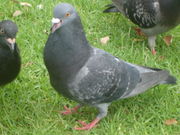
Varying eye colour in Rock Pigeons.
The bowing courtship, when the metallic lustre of the
neck is fully displayed, often takes place on ledges where
Guillemots and Razorbills sit.
A small prehistoric
subspecies of the Rock Dove that lived during the last ice
age in Italy has been described as Columba livia minuta.
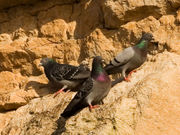
Rock Pigeons in their natural
habitat perched on sea cliffs. Most pigeons in an urban environment
substitute sheer building facades for cliff
faces
Nest and Nestling
The nest is usually on a ledge in a cave; it is a slight
structure of grass, heather, or seaweed. Like most pigeons
it lays two white eggs. The eggs are incubated by both
parents for about 18 days.
The nestling has pale yellow down and a flesh-coloured
bill with a dark band. It is tended and fed on "crop
milk" like other doves. The fledging period is 30 days.
Egg, measured in centimetres
|
|
Newly hatched nestling and one egg
|
|
|
|
Nestlings, about ten days
|
|
Domestication
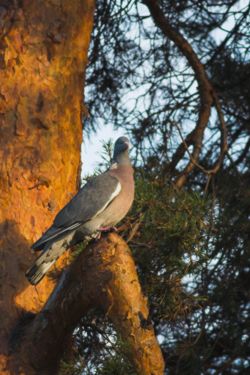
In tree
Rock Pigeons have been domesticated for several thousand
years, giving rise to the domestic pigeon. Trained
domestic pigeons are able to return to the home loft if
released at a location that they have never visited before
and that may be up to
1000 km away. A special breed, called
homing pigeons has been developed through selective
breeding to carry messages and members of this variety of
pigeon are still being used in
pigeon racing.
Pigeons are also bred for meat and by fanciers to develop
many exotic forms. Among those forms are the
carrier pigeons, a variety of pigeon with wattles and a
unique, almost vertical, stance (pictures).
Young pigeon meat is often sold under the name squab.
Pigeons' extraordinary navigation abilities have been
attributed to the theory that they are able to sense the
Earth's magnetic field with tiny magnetic tissues in
their head. This is all the more surprising as they are not
a
migratory species, which is a fact used by some
ornithologists to dispute the "compass pigeon" theory.
Many domestic birds have escaped or been released over
the years, and have given rise to the feral pigeon.
These show a variety of plumages, although some look very
like the pure Rock Pigeons. The scarcity of the pure wild
species is due to interbreeding with feral birds.
Many people consider pigeons to be pests but they have
made contributions of considerable importance to humanity,
especially in times of war. In war the homing ability of
pigeons has been put to use by making them messengers.
So-called
war pigeons have carried many vital messages and some have
been decorated for their service. Medals such as the Croix
de guerre, awarded to Cher Ami, and the Dickin Medal awarded
to G.I. Joe have been given to pigeons for their service.
Domestic pigeons are also commonly used in laboratory
experiments in biology, medicine and cognitive science. They
have been trained to distinguish between cubist and
impressionist paintings, for instance. In another project,
pigeons were shown to be more effective than humans in
spotting shipwreck victims at sea. Current (2004) research
in pigeons is widespread, encompassing shape and texture
perception, exemplar and prototype memory, category-based
and associative concepts, and many more unlisted here.
Feral pigeons in cities
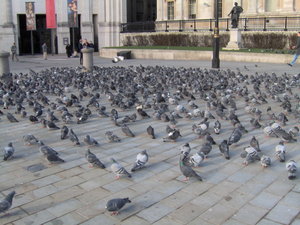
Although feeding them is now forbidden, pigeons
still flock to London's Trafalgar Square
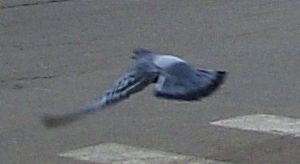
Pigeon in flight
Feral pigeons, also called city doves or city
pigeons, find the ledges of high buildings a perfect
substitute for sea cliffs, and have become abundant in
cities all over the world. However, they are often
considered a pest or even vermin, owing to concerns that
they spread disease, damage property, cause pollution with their excrement, and drive out other bird
species. Alternative, pejorative, nicknames for pigeons are
sky rats, rats with wings, or gutter birds.
In
Montreal, Quebec, Canada, they are also commonly
referred to as flying ashtrays.
Many city squares are famous for their large pigeon
populations, including:
- Trafalgar Square — London
Dam Square — Amsterdam
Martin Place — Sydney
Piazza San Marco — Venice
Misir Carshisi — Istanbul
Rynek Główny — Cracow
Richard J. Daley Center — Chicago
Piccadilly Gardens — Manchester
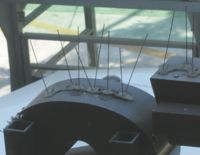
Many places where pigeons could land are covered
with spikes
In the mid 20th century, the pigeons in Trafalgar Square
were considered a tourist attraction, with
street vendors selling packets of seeds for visitors to feed
the pigeons. The feeding of the Trafalgar Square pigeons was
controversially forbidden[1] in 2003 by London mayor Ken
Livingstone. However, activist groups such as Save the
Trafalgar Square Pigeons[2] flouted the ban, feeding the
pigeons from a small part of the square that is under the
control of Westminster City Council, not the mayor. The organisation has since come to an agreement to feed the
pigeons only once a day, at 7.30am[3].
Although pest exterminators using poison, a
hawk or nets have been employed at ground level to
control urban pigeon populations, the effect is limited and
very short term. Pigeons breed when the food supply is good
— for wild rock doves this might be on a seasonal basis so
they usually breed once a year. In the urban environment,
because of their year-round food supply, feral pigeons will
breed continuously, laying eggs up to six times a year.
Feral pigeons can be seen eating grass seeds and berries
in urban parks and gardens in the spring, but there are
plentiful sources throughout the year from scavenging (e.g.
dropped fast-food cartons). Further food is also usually
available from the disposing of stale bread in parks by
restaurants and supermarkets, from tourists buying and
distributing birdseed, etc. Pigeons tend to congregate in
large, often thick flocks when going for discarded food, and
many have been observed flying skillfully around trees,
buildings, telephone poles and cables, and even moving
traffic just to reach it.
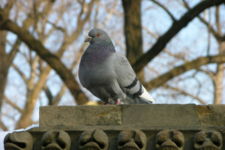
A Rock Pigeon perched in
Central Park
Long term reduction of feral pigeon populations can only
be achieved by restricting food supply, which in turn will
involve legislation and litter (garbage) control.
As a result of the continuous food supply, pigeon
courtship rituals can be observed in urban parks at any time
of the year. Males on the ground initially puff up feathers
at the nape of the neck to increase their apparent size and
thereby impress or attract attention, then they single out a
female in the vicinity and approach at a rapid walk, often
bowing as they approach. Females invariably initially walk
away or fly short distances, the males follow them at each
stage. Persistence by the male will usually eventually cause
the female to tolerate his proximity, at which point he will
continue the bowing motion and very often turn full- or
half-pirouettes in front of the female. Subsequent mating
when observed is very brief with the male flapping his wings
to maintain balance on the female. Sometimes the male and
female beaks are locked together.
Nests are rudimentary as for the wild doves and pigeons.
Favourite nesting areas are in damaged property. Mass
nesting is common with dozens of birds sharing a building.
Loose tiles and broken windows give pigeons access — they
are remarkably good at spotting when new access points
become available for example after strong winds cause
property damage. Nests and droppings will quickly make a
mess of any nesting area. Pigeons are particularly fond of
roof spaces containing water tanks, though they frequently
seem to fall into the tanks and drown. Any water tank or
cistern in a roof space needs to have a secure lid for this
reason. The popularity of a nesting area seems little
affected if pigeons die or are killed there — corpses are
seen among live birds, who seem unconcerned.
On undamaged property the gutters, chimney pots and
external ledges will be used as nesting sites. Many building
owners attempt to limit roosting by using
bird control spikes and netting to cover ledges and
resting places on the facades of buildings. These probably
have little effect on the size of pigeon populations, but
can help to reduce the accumulation of droppings on and
around an individual building.
Only the larger and more wary
Wood Pigeon (which often shares the same territory and
food supply) will build a tree nest; for some reason it
prefers trees close to roads.
The coo-ing of the feral pigeon is almost continuous when
birds are on a nest; it is rarely heard at other times
except courtship. Males are at least as likely to be on the
nest as females, though a pair of birds will attend the
nest.
Peregrine Falcons which are also originally cliff
dwellers have also adapted to the big cities, living on the
window ledges of skyscrapers and often feeding exclusively
on Rock Pigeons.
See also
References
- BirdLife International (2004).
Columba livia. 2006
IUCN Red List of Threatened Species. IUCN 2006. Retrieved on 08 May 2006. Database entry
includes justification for why this species is of least
concern
- Collins Bird Guide by Mullarney, Svensson,
Zetterström and Grant
ISBN 0-00-219728-6
-
Columba livia (TSN 177071).
Integrated Taxonomic Information System. Accessed on 9
February 2006.
External links




